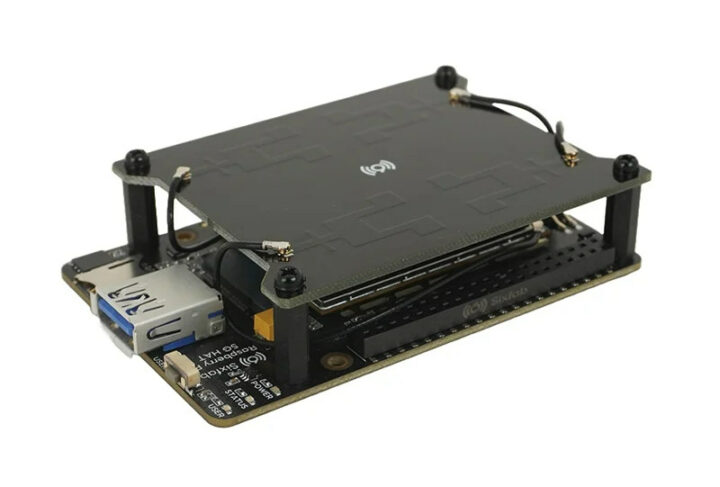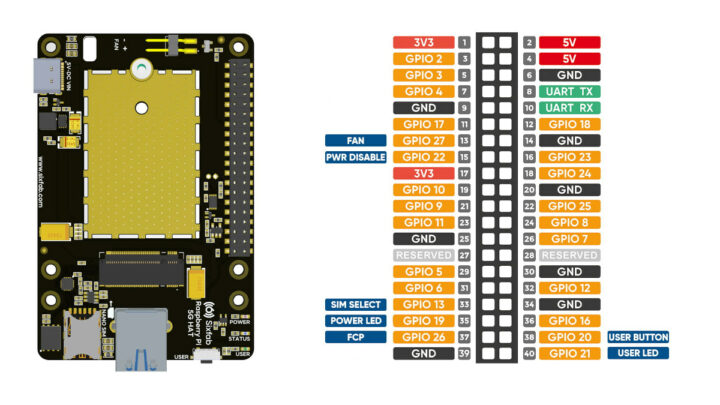
Sixfab has just launched a 5G Modem Kit for Raspberry Pi 5 with a Raspberry Pi HAT that takes Quectel RM502Q-AE 5G Sub-6GHz M.2 module working globally (except China), a “patent-pending” internal antenna for Sub-6 frequency bands designed by SixFab, and a USB 3.0 bridge connector.
SixFab 5G modem Kit for Raspberry Pi 5 highlights:
- Sixfab 5G Modem HAT for Raspberry Pi 5
- M.2 socket for 5G module
- Nano SIM card holder + embedded SIM
- USB 3.0 port and 40-pin GPIO header for connection to the Raspberry Pi 5 SBC
- Misc
- User button
- Status, power, and user (GPIO21) LEDs
- EEPROM for Raspberry Pi HAT compliance
- 2-pin fan connector
- Power Supply – 5V via USB Type-C port (on HAT itself)
- Dimensions – 88.1 x 57.7 x 21.7 mm
- Approvals – FCC, IC, CE, UKCA are in progress
- Quectel RM502Q-AE M.2 module
- 5G NR: 3GPP Release 15 NSA/SA operation, Sub-6 GHz
- LTE Category: DL Cat 20/ UL Cat 18
- Max data rates (Provided by SixFab, and they differ from the info on the Quectel RM50xQ series page)
- 5G SA Sub-6 – Max. 4.2 Gbps (DL)/Max. 450 Mbps (UL)
- 5G NSA Sub-6 – Max. 5 Gbps (DL)/Max. 650 Mbps (UL)
- Host interfaces – USB 3.1 or PCIe 3.0
- Dimensions – 52 x 30.0 × 2.3mm
- Weight – 8.4 grams
- Extra tall 40-pin GPIO stacking header
- Power Supply – 5.1V 3.0A DC power adaptor with universal plugs
- Plastic spacer kit

While the Quectel RM50xQ series module can support GNSS, this is not implemented in the Sixfab 5G modem kit for the Raspberry Pi 5. The Quectel module is supposed to support either USB 3.0 or PCIe Gen 3.0 host interface, and instead of using the PCIe FPC connector, Sixfab decided to use one of the USB 3.0 ports on the latest Raspberry Pi SBC, probably because of the lack of documentation for the non-standard PCIe connector at launch, and it’s also slightly easier to install that way.
Seeing this design, I initially thought the 40-pin GPIO header was not used since USB 3.0 should be sufficient, but the documentation provides further details, and some of the GPIO pins are used to control a fan, turn on/off the Sixfab HAT to save power, select the SIM (Nano SIM card or eSIM), the user button, the user LED, the power LED, and something called FCP to controls the power on/off sequence of the 5G module itself.

But all those pins might be optional since the company says the kit can be connected via a USB cable to other boards and computers such as the NVIDIA Jetson Nano Developer Kit, Beaglebone SBC, Asus Tinkerboard, NXP i.MX 8 devkits, and regular PCs with both Windows and Linux drivers and tools available.
You may think that since smartphones support 5G getting a thin antenna board may not be such a big deal, but Waveshare introduced a similar Snapdragon X55-based 5G modem kit for the Raspberry Pi 4 in 2020, and it looks huge (see below) with external antennas compared to the new 5G modem kit for Raspberry Pi 5 relying instead on internal PCB antennas.

So the size of 5G Raspberry Pi kits has come down dramatically, the same cannot be said of the price with the Sixfab 5G modem kit for Raspberry Pi 5 currently sold for $450 on the company’s website [Update: as of January 2024, the price has come down to $350]. You’d still need to add a Raspberry Pi 5, a microSD card for the OS, a 5G SIM card (unless using the eSIM is an option), and an additional 5V USB-C power supply since both the Raspberry Pi 5 and Sixfab HAT need to be powered separately.
US customers may prefer to use the kit with T-Mobile since it works right out-of-box without requiring device registration, and registering the kit with Verizon and AT&T networks may require some complicated paperwork and should only be suitable for advanced users.

Jean-Luc started CNX Software in 2010 as a part-time endeavor, before quitting his job as a software engineering manager, and starting to write daily news, and reviews full time later in 2011.
Support CNX Software! Donate via cryptocurrencies, become a Patron on Patreon, or purchase goods on Amazon or Aliexpress. We also use affiliate links in articles to earn commissions if you make a purchase after clicking on those links.




Good. Order one
Isn’t it much better if the connection is via PCIe and not via USB?
Probably not much difference here. The USB 3.0 port is rated 5 Gbps, while the PCIe interface on Pi 5 officially supports PCIe 2.0 x1 (5 Gbps). The PCIe interface can also work up to 8Gbps when configured as PCIe 3.0 x1 (8 Gbps), but Raspberry Pi does not guarantee stability with this setting.
Finally, the Quectel model supports up to 5 Gbps downlink when connected to 5G, so it’s unlikely to fully saturate the USB 3.0 interface in most cases.
Using the PCIe interface would however save one of the USB 3.0 ports so users could do something else with it.